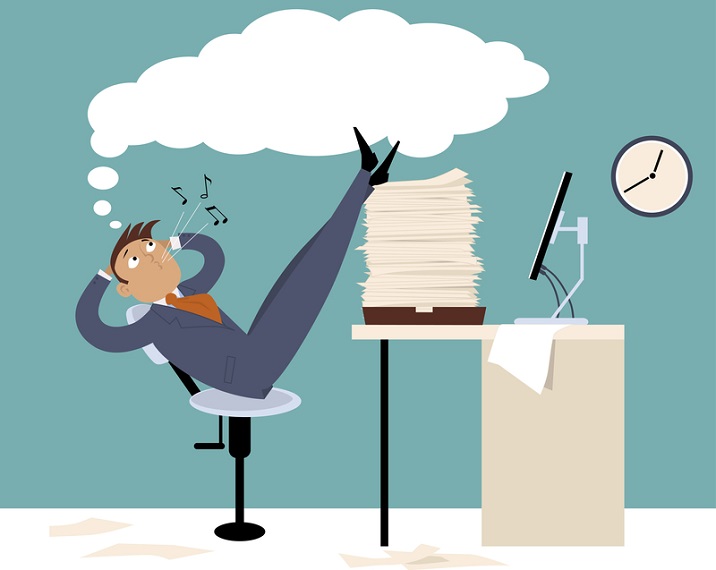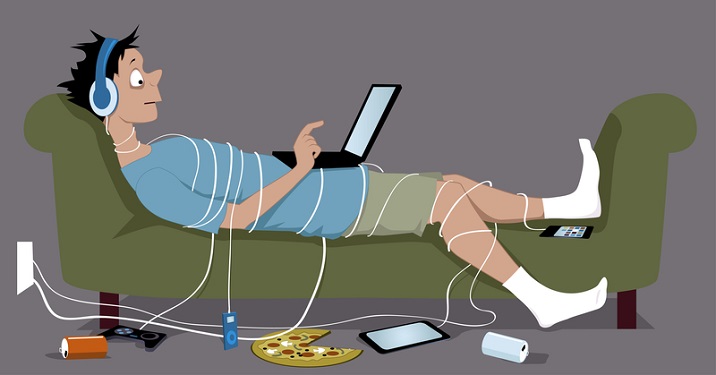
- Attention Management - Home
- Attention Mngmt - Introduction
- What Causes Attention Deficit?
- Attention Deficit at Workplace
- Four Kinds of Attentive People
- Thinking Less Leads to Attention
- Types of Attention
- Meditation Improves Attention
- Activity to Increase Attentiveness
- Attention Zones Model
- Keeping Yourself Focused
- Why People Procrastinate?
- How to Overcome Procrastination?
- Prioritizing Your Time
Attention Management - Quick Guide
Attention Management - Introduction
Attention Management can be defined as a set of practices that increase peoples ability to concentrate on important things at work and in life. It also helps to arrange their priorities, so that they can deliver efficiently at organizational as well as personal levels.
Managers all over the world will tell you that a small but attentive workforce is much more productive than a large distracted workforce. An inattentive employee will make careless mistakes and end up being less productive. People from all fields have to be attentive to excel or at least retain their position.
Distractions include gossiping with co-workers, taking long breaks, handling personal matters during work hours, etc. These distractions generally take place due to boredom, working for long hours and mundane working conditions. One could prevent wasting time by focusing on specific goals.

Attention deficit can hamper the chances of a sincere employee too. If his teammates dont pay attention to what he says, his work is less than effective. The ability of staying attentive helps professionals relate with their work on an emotional level. It also encourages them towards greater productivity to meet the companys as well as their personal goals.
With increasing workload, people are easily stressed out and are easily distracted from work. Attention Management allows the managers and employees to focus more on their work with minimal distractions. This helps them to perform better and this in-turn leads them into getting a hike and a promotion.
We are not very far away from a future, where things like integrity, sincerity, etc., will make way for Attention as the most valuable commodity. On the other hand, work-related skills will make way for Focus as the most important skill in a workplace. To be relevant and successful in that future, we have to learn how to be focused and attentive from today itself.
What Causes Attention Deficit?
Social media has changed the way we people used to communicate, make new relationships, and develop them. It is also changing the way people used to handle multiple tasks at the same time. What was just a proposed theory years before, has now become an established fact that multitasking actually fails both the purposes, it was supposed to solve.
It is widely accepted now that multitasking actually takes more time to complete work and then, the quality is always poorer. In the age of technology and services, we have got used to instant gratification of curiosity and getting answers. In such situations, people have lost the patience to research for facts.
How Digital Media Changed Our Attention Spans?
Digital Media and technology have converged to produce more information now than ever. This means that people are encouraged to collect fleeting information, as compared to reading and analyzing the information. Then later, the facts are separated from fiction.
Attention has become a valuable asset today and the digital media uses it as currency. Gone are the days when online companies used to make money off direct sales. Nowadays, they have all entered into an indirect model of revenue generation. This is a model where they strive to become an established platform that is being visited by the internet-browsing crowd. It is all about eyeballs, clicks, taglines, petitions.
Bombarding of Information
Bombarding of information on the online outlets can cause someone's attention to fluctuate very easily. It is just like someone who has just walked into a buffet meal and finds a wide range of dishes laid in front of his eyes. As he cannot try his hand at all the dishes at the same time, he will have to pause after a few dishes. Once he is done, he won't go back to those dishes, even if he found them really delicious. He reasons, "Why have all of some things nice, when I can have some of all things nice?
The World is Getting Smaller
If you have seen the movie, Pirates of the Caribbean: Worlds End, you must have seen the beautiful, retrospective moment, where Captain Barbosa reflects that the world is getting smaller. To which Captain Jack Sparrow replies in his imitable style, No. The worlds still same, mate; theres just less in it.

In a nutshell, this is the problem people are facing with content nowadays. Thanks to the advent of technology in our life, we can travel the entire world with a simple click of the mouse.
A few clicks will take us to the top of the Great Wall of China and a few more will take us to the icy plains of Greenland. The world does seem a smaller place now, thanks to the Internet that has more speed than the winds that sail ships. But when a few clicks can take us all over the world; do we really have time left to let one beautiful image stay on our computer screen, so that we can look at it for long, let it stir our emotions?
Attention Management - Deficit at Workplace
According to a poll released by Salary.com, 14% of employees of a company waste 3 hours daily, 22% waste 2 hours a day and 64% waste 1 hour a day. One of the biggest culprits was internet-surfing, which caused 48% of employees to waste their time on it.
A functional objective behind every company and subsequently every manager is to increase productivity. Every company wants the best from their workforce, but it would be overwhelming to use a small team to do multi-tasking and increase profits. This is where a manager comes into picture; a manager tries to extract more from less.
When you try to think on the lines of how attention deficit affects us in our daily lives, we can see that things have not been very different for us within the confines of the office chambers as well. Companies have started to come to terms with the fact that their employees are now getting more and more distracted from their work. Even those who focus on their work are more interested in getting a large volume of work done, as compared to getting the work done properly.
Quantity has replaced quality
Just as todays generation is more likely to lay its eyes on the Mona Lisa Smile and say, Well, thats it, its done! Bring in the next one! I havent got all day!.

A manager is more likely to say to his team to sacrifice more and more quality at the altar of quantity, as he himself does not have the attention needed for a detailed quality check. When someone like this becomes a manager, he is suddenly asked to focus on some very specific areas of organizational operation, such as delivering training, increasing expertise of the team and paying attention to the closest details.
Managers need to be able to overcome their own distraction issues, both in their personal and professional lives, before they instruct their team-mates about it. A distracted manager cannot maintain an attentive team. So, the first thing one should consider is where they focus most of their attention.
CEOs Leads the Company
To determine the attention management of a company, one has to determine the attention of its CEO. A CEO should pay attention to the company and its employees to yield better productivity. Its important that the CEO understands the different types of attention and various attention management techniques to encourage their employees.
Four Kinds of Attentive People
After studying the different attention spans of people from different fields and time management, experts have divided attention into four different areas. The skills of these people are taken from various spheres of life and age groups. These include −
Intentional − People exhibiting intentional attention already know what they are doing and what they actually want to do. This is called working knowingly or intentionally. They plan strategically and note down the pros and cons of their decision and prioritize their activities accordingly.
Responsive − People exhibiting responsive attention are not aware of the different situations they are going to face, but they respond according to the surroundings when they arrive at it. They dont plan beforehand, but respond according to the current scenario. They even tend to spend lesser time in working intentionally.
Interrupted − People exhibiting interrupted attention get easily distracted from their work. They dont have a priority set to balance their life. In fact, they spend most of their time answering messages or handling situations, which are not at all related with their work or divert them from their work.
Unproductive − People exhibiting unproductive attention are least bothered about their productivity. They spend most of their time letting their thoughts wander. They abuse office working time by taking breaks, chatting or any other unproductive works.
Every person can be categorized into any of these categories depending on their nature towards their work and the way they handle their personal and professional life. The more you are attentive, the more you realize your surroundings and the more productive and effective you are.
Thinking Less Leads to More Attention
Stop Thinking may sound like a weird concept to someone trying to attempt attention management. The logic behind this two-worded advice is to draw peoples attention towards their tendency to over-think different stuff. This will eventually make them worry about irrelevant things. When a manager starts thinking overtime, he pays less attention to what is actually going on in the team and neglects the things which actually demand his attention.
What we think and perceive is always controlled by our feelings. If we feel something is boring, we pay less attention to it. Thats the reason why students attending a conference which they believe is no way useful to them, will start paying less attention to it, and eventually find it boring.
When you become attentive, you start connecting better with the world around. You begin understanding the working of a process and seeing the big picture. Attentive people process emotions better than others because their minds are calm and their thoughts are clear. Chinese have a term for it Mushin.

What Is Mushin?
Mushin is a Chinese word which means no mind. The concept of Mushin is used in training for different martial arts. Mushin teaches people to completely forget emotions and conscious thinking, so that they can concentrate on a task.
Mushin a state of mind that one can achieve through meditation. Its the best way for someone to understand himself and have a positive nature towards the world around him. This makes him more attentive about everything, become calm and hone better intuitive skills.
What is Xin Yi?
Xin Yi means heart minded. It is a technique that attempts to connect ones body with his soul. According to the Chinese, there are internal harmonies that can connect mind with will, energy, and power.
They are −
Xin and Yi − Connecting the mind (Xin) with heart (Yi).
Yi and Qi − Connecting the heart (Yi) with natural energy (Qi).
Qi and Li − Connecting the natural energy (Qi) with power (Li).
Meditation helps us obtain these internal harmonies, connect our body with our mind and heart as well. It clears our minds, enables us to stay calm and more focused all these are qualities that a working professional needs to perform his duties efficiently in the office.
Attention Management - Types of Attention
Attention isnt a constant phenomenon. A person can change his attention span and intensity of attention depending on different situations. There are three types of attention depending on the working type of an individual −
Focused Attention
Focused attention means paying attention. Under certain situations, people can channel their complete attention on a single task and everything else is considered as less important. This can be seen while studying for an exam or working on a project.

It is very difficult to sustain this type of attention for a very long time in normal cases, as it needs an engagement on a physiological level. Humans are bound to get tired from their work after certain period of time. For example, the same way a person is less likely to concentrate on studies, after studying vigorously for more than a couple of hours at a stretch.
Sustained Attention
Sustained Attention means concentrating on a certain time-consuming task. People employ such attention when they are watching a magic trick or watching an interesting movie. There are three stages of sustained attention −
Paying Attention − Where you start focusing.
Keeping Attention − Where you sustain your attention.
Ending attention − When you finally stop paying attention.

This entire cycle is called one Attention Span. Once your attention ends, you will again need some time to focus again and remove the distractions. People get distracted from work which leaves the task incomplete, so one needs time to refocus and start after sometime.
Selective Attention
Selective Attention means focusing on a single stimulus in a complex setting. Its like having a conversation in a crowded station, where its impossible to focus on everything going around. In this case, one has to really focus on the conversation and ignore everything else happening to get the message across.
One must have the ability to focus on a particular message or object by filtering all background noise. The negative part is that people tend to neglect what is going around (even if its important). In all this, the message they receive can easily be manipulated or misunderstood due to communication issues.
Alternating Attention
People exhibiting alternating attention have the ability of switching their attention to more than one task at the same time. Many of us have exhibited this attention by taking notes, while simultaneously listening and understanding a lecture. Here, the mind should be flexible and quick to understand and translate every information gathered.
Attentional Blink
According to a theory that was first proposed in the 90s, attention is just like vision. When we try to visualize two targets at the same time, one of them appears sharp while the other one gets blurred. Similarly, when people focus on two targets at the same time, they tend to miss the second one. When these targets are linked with strong emotions, it becomes easier to reduce attention blink.
Meditation Improves Attention
From the time you wake up till the time you sleep, your brain keeps sending and receiving messages through a network of nerve connections, which are called brainwaves. Each brainwave is linked with different activities like sleep, attention, music, relaxation etc. These brainwaves are classified into Alpha, Beta, Theta, Delta and Gamma rays.

Alpha Brainwaves
Alpha Brainwaves Alpha brainwaves signal relaxed consciousness. They are considered as the brainwaves of meditation as they increase creativity and are linked with positive feelings and tranquility. When a person is awake, but not intently focused on something, he is in Alpha. This is the best state for intuitive thinking.
Beta Brainwaves
Beta brainwaves signal wakefulness. They are linked with focus and attentiveness. These brainwaves are used to solve problems, so they are also linked to feelings of trepidation and anxiety. When you are awake, you are in Beta. Meditation slows down Beta brainwaves, calms you down, makes you less anxious and helps you focus on the other brainwaves.
Theta Brainwaves
Theta waves signal a deep state of meditation or hypnosis. People in light sleep are also in Theta state. They are linked with dreams and short term memory. They help you recall facts and are more active in children than adults. A person in Theta is not completely aware of what is going on around.
Delta Brainwaves
Delta waves signal a deep slumber without any dreams. This is considered as the slowest brainwave pattern, moving at 1.5 to 4 cycles per second. Some people enter delta when they are meditating. Only experienced practitioners can attain reach delta waves while still remaining awake.
Gamma Brainwaves
Gamma waves signal the ability to relate and process information. It increases memory power and maintains sharpness in senses. High gamma waves make a person more positive, active and content. It also makes people intelligent than others, they can also be attained through meditation. Meditation helps you have a control over these brainwaves. When we meditate, different meditation techniques influence brain waves that are responsible for different activities.
However, meditation is not the only way to increase focus and attentiveness. There are different methods that help also help us in this objective. One of the most common among them is Visualization.
In visualization techniques, a person is asked to use his imagination to create mental images that an instructor asks him to do. This increases brain activity and brings immense focus on work.
Every individual is different from the other, so they need different method or combination of methods to concentrate more. One has to understand the method best suited to him.
Activity to Increase Attentiveness
The following worksheet has a collection of activities that a person can engage in his daily life. These activities assure that he can manage to keep his attention sharp and focused. Most of these activities yield results on a long-term basis, so the practitioner needs to have patience while expecting results. However, he will start feeling an immediate change in his outlook in a week itself.
Exercise
Relax and sit comfortably in a quiet place.
Try thinking of nothing and dont entertain any other thoughts.
Concentrate on your natural breathing. Listen to the inhale-exhale sounds.
Meditation
You can meditate in different ways, but the aim should be to relax your senses and calm your mind. Some of the widely followed methods of meditation are −
- Mantra Meditation
- Steady Gaze Meditation
- Transcendental Meditation
- Chakra Meditation.
The Steady Gaze Meditation includes visually concentrating on an object. The Transcendental Meditation involves simply sitting with eyes closed. The Chakra Meditation involves focused breathing and mantra to explore the chakras.
Different meditation ways focus on different things, so you have to select the one area that you need maximum concentration and focus on and then start the practice accordingly.
Visualization
Visualization means imagining your goal and believing that it will happen. Visualization technique is nowadays being used by people to excel in different fields through sharpening their attention and making them materialize their thoughts. The reason its so effective is it actually allows your mind to focus on the possibility and helps you achieve your goal; rather than just thinking and then dismissing it as some vague wish.
A few prerequisites to visualization −
Choose a goal − You have to be precise to select and visualize an individual goal.
Relax − You need to calm your senses before concentrating on visualization.
Visualize − Picture the goal. For example an architect picturing a resort in a desert.
Accept − Trust yourself that you can make your dream come true.
Example
A scientific study was conducted to prove the effects of Visualization. The study involved a group of players who were given free-throws of basketball at the university of Chicago. This study first analyzed a players ability for free-throws and then divided them into three groups.
The first group was asked to practice with the ball for an hour every day
The second group was asked just to stand and imagine how would they take a shot.
The third group was simply asked to ignore.
After 30 days, the players in the first group showed 24% improvement, the players in second group showed 23% improvement, while the third group showed no improvement. The effect of visualization can be clearly seen here.
Attention Management - Zones Model
Attention management helps people manage stress, be more productive and manage time better. Attention management requires that you not only concentrate, but also implement. Sometimes, we fail because we are intimidated by success. It is very important to have a positive thinking, while you execute a plan. This will help you focus more.
We can divide attention into four different zones: Reactive, Proactive, Distracted and Wasteful. The more attentive you are, the more it reflects in your productivity as well as personal stress levels.
Reactive Zone
Managers especially feature heavily in the reactive zone, as they deal in meeting deadlines and taking decisions of tasks that demand time and attention. For example, they are in a project thats near to deadlines and one of their employees calls out sick and he has to arrange for someone to fill in.
Such crises dont help the managers meet their goals or deadlines. With major tasks come unexpected situations. Most of them mainly happen because of improper time distribution. In order to move from the reactive zone to proactive zone, they should try to waste less time in being distracted.
Proactive Zone
People in a proactive zone are willing to work harder, and like to follow some strategy or procedure to attain their goals. They always like to plan in advance accordingly to achieve their goal. If you spend more time in this zone, you can minimize your time in the reactive zone. This zone helps you maintain balance in your personal and professional life.
Staying in the proactive zone also helps you to have a positive attitude towards your work and colleagues. It helps you budget your earning, maintain cordial relationship, review your goals and adjust the changes required to achieve it. It also improves your performance with time.
Distracted Zone
This is the zone where most of us spend more time than we are actually supposed to. These activities appear as if they demand your urgent attention, but they are not actually that important. This happens when people start distracting you or you start prioritizing needs of others before that of yours. IM-pinging, frequent emails, phone calls, or chatting comes under this zone.
Leaving the Distracted Zone
As you must have realized by now, this is not the best zone to be in. If you are in this zone, try to move away from it as soon as possible. This can be done in the following ways −
Turn off email alert − Not every email is so urgent that it needs to be answered as soon as you receive it. Email alerts often distract you and sometimes take you from the Proactive Zone to Distracted Zone.
Create a time-blocked schedule − Dont entertain phone calls or emails while working. Schedule a time to return calls and reply to mails, while maintaining a cordial relationship.
Set boundaries − Make a schedule and follow it. Never allow others to distract you in your actions, unless its really urgent. Once you start following your schedule, people will slowly adapt to it and stop distracting you.
These methods will help you come out of the Distracted Zone and focus more on the important and urgent work. It will help you focus more on the work which actually demands your attention and will help you obtain your goal.
Wasteful Zone
People tend to waste their time without any external provocation. People in this Wasteful Zone engage in meaningless chit chatting, doing nothing, checking emails, gossiping with colleagues, and browsing on Facebook, Twitter. The main objective for people in the wasteful zone is to shift to the Proactive Zone. They should think of the goals they want to achieve and how wasting time by indulging in unproductive activities takes them away from their dreams and ambitions.
People here spend more time in relaxing and imagining stuff than actually doing something productive or being useful. Shifting your attention away from this zone can be done in the following ways −
Schedule personal time − It is impossible to focus on a task always, so its better to take short breaks in a while, and then get back to your work. Always have sometime for yourself to chill, eat, mediate and relax.
Limit temptation − Avoid getting tempted into spending time chatting, using phone, and browsing the internet, instead of concentrating more on work. It is better to turn off your cell phone or always take short breaks. Keep in mind that it will take the same amount of time to complete the work, so the time wasted indulging in trivialities is actually delaying the work.
Keeping Yourself Focused
Its easy for someone to advise a person to Stay Focused, but its difficult for the same person to hold on to their focus themselves. The truth is that today, one can easily get distracted and overwhelmed with all the goals and plans in their busy lives. In such times, there are ways in which people can retain their stability and focus.
The One Minute Rule
We pay less attention to small errands and tasks because we tend to underestimate their value. Once these tasks pile up, they end up taking a lot more of time and attention than they would have originally taken.
Imagine not washing clothes for a month and then you wake up one day to the fact that you have no clean clothes. Whats worse, you will have to clean a huge pile of clothes now instead of a pair. The one-minute rule removes this type of a situation by making you focus on reducing stress. This one-minute rule teaches us that small tasks, when done daily, does not affect us much, but once they are left to be done later, they take a lot of time to be completed.
This one-minute rule tells us to ask ourselves, how much time will a few tasks like filing a paper, putting the books in the shelf, keeping our socks near the basket, etc., actually take. People realize that it takes only a minute to do these mundane tasks, but once they pile up, it can end up consuming an entire weekends worth of time to get the room clean and organized.

The Five Minute Rule
The Five-minute rule teaches us to take a five-minute break between every task as this will help us stay relaxed and focused on our work. In addition to that, the rest will help us complete one task before moving to another.
Developing a proper schedule helps you to have better time management. However, the most common mistake people make while making a schedule is they make it too strict. It is common to be overwhelmed with all the goal setting and scheduling. At the same time, it is also important to control your emotions and not let them control your actions or dictate your schedule.
This can be done by following the steps given below −
Stop − Panicking doesnt help. It freaks you out and wastes time as well. Calm down and try to think about all the outcomes. Try to relax and think clearly before reacting.
Take Breaks − Focusing on your goal is important, but dont forget to take a five minute break from your work to calm your mind and body. Short-term meditation or other relaxation techniques can help.
Break Down Tasks − Try completing a task by breaking them into smaller sections. This will give you a better picture of the work and will help you complete it faster in an organized way.
Sleep − Its always important to get adequate amount of sleep, to relax your mind and get your head clear. A tired brain leads to inefficient work.
Why People Procrastinate?
Procrastination is the act of postponing doing tasks to a later time or date. It is said to be the single biggest threat to productivity. It is good to take a break, but procrastinating affects any chance of long-term success.
Every one of us goes through a bit of procrastination once in a while. Having said that, there are some chronic procrastinators, who start avoiding things just because they dont feel like it, when work actually needs to be done.

We all have seen situations where five-minute breaks become a break of 60 minutes. It happens when we are really tired or have utilized our concentration on a mentally-exhausting work. However, sometimes we end up taking such breaks for probably no reason other than that we are tempted to do other unnecessary things. For such people, a five-minute internet browsing can easily convert to two hours on Facebook.
People dont procrastinate instinctively
People dont procrastinate instinctively. Many of them meticulously plan how they are going to do their tasks, but at a later time. Laziness is one of the main reasons for procrastination. However, some do it so that they can get a better deal from the wait and watch strategy.
Invariably, procrastinators will procrastinate and use various excuses to justify their actions (or rather inactions).
Some of the most common excuses that a procrastinator tends to give are −
Stress − They will say that they have been working for long hours and have become exhausted, which is why they end up taking long breaks. This is irrespective of the fact that majority of the time spend in working such long hours would be dedicated to idle net-surfing or gossip.
Fear − The fear of failure and intimidation of success, both can lead to procrastination. Some people give the excuse that they arent emotionally strong enough to bear the consequences of their wrong actions and prefer to not act at all.
Boredom − Sometimes people say that they get bored which made them haul all work to a later date. A genuinely bored person will look to do just about anything to get rid of it, instead of inviting it with some more inactivity.
The reasons, or shall we say excuses, for procrastination are always different for different people. This is only because people think and act differently. Not to forget their goals and expectations from life are different.
Note that everyone of us has this tendency to go through this phase of procrastination at least once in a weeks time. However, not everyone of us becomes a lazy work-shifter.
How to Overcome Procrastination?
Procrastination feeds on people, who have no control over their emotions and those people, who dont know how to schedule their work. People who are in the habit of constantly changing their goalposts need to first decide whats most important to them in the long run.
Walking out of the office and munching onto a snack with hot tea will appeal to just about anyone, especially on a hot Wednesday afternoon. On the other hand, an emotionally-strong person would know that the same treat is waiting for him once he is done with this present task.

The following steps will help people balance their priorities and get better time management skills. Here are some ways in which you can get over procrastination −
Delete It − What happens if you dont work at all? Think of the work which requires your immediate attention and what happens if you leave some behind.
Delegate − Ask yourself if you are responsible for the task completion in the first place, or if the work can be given to someone else. Always be clear about your role in a task, so that you dont confuse your work with that of others.
Do It Now − Ask yourself if the task needs immediate attention or it can be postponed for some time. Be honest in answering this question, as delaying important work always increases stress and anxiety.
Ask for Advice − It is ok if you dont know everything. You can always seek advice from a trusted guide or senior that may help you and guide you in your work. It is a much better step than offering lack of knowledge as an excuse for not doing that work.
Chop It Up − You can always make a big task small by diving them into smaller sections. As these bits take your mind off the huge task and make you focus on one at a time. This makes the work becomes easier to complete.
Obey The 15 Minute Rule − To avoid procrastination, try allotting every actionable step for your work 15 minutes of time, and not more than that. Work in bursts of 15 minutes during which you wont allow any distractions.
Have Clear Deadlines − Have clearly-defined deadlines and have a planned way on how you are going to achieve your goals in the deadlines. Before setting deadlines, have a look at your team and draw a realistic deadline.
Give Yourself a Reward − Every time you complete a deadline, dont forget to give a treat to yourself and others. This will keep the team motivated and tell you that you did a good job.
Remove Distractions − Try to maintain a positive working environment around, limit distractions that come from gossiping, internet-browsing, etc. This will help people focus more on their work.
Attention Mngmt - Prioritizing Your Time
For successful Attention Management, you need to begin with prioritizing things. The next step is to acknowledge that there is an urgent need for you to move your positive energy in a productive direction. This helps you to maintain a balance and move forward towards your goal with better time management.
Being Assertive
Sometimes people will ask you to help them with some assignment that demands your immediate attention. However, it may not be linked with your own work. These requests may consume the time your work needs, and at the same time, they cannot be neglected. The best way of handling this situation is to learn the art of politely saying No.
This can be done in the following ways −
Refusing to take up the assignment, followed by an honest explanation, like- I am sorry I cant help you, because I am not comfortable doing that.
When you say no instead of making an excuse, it gives the listener a real and honest idea of your situation. It also lets the person know that you are not someone who he can take for granted. Of course, giving a proper reason helps greatly in not creating any bad feelings later. For example, I cant help you right now because I have another project that is due by tomorrow.
When you say no, try and give an alternate solution to the listener, this will help them think of some different solution and also not make them think negatively of you. For example, I cant make it today, but we could schedule it in for tomorrow morning.
Every time you say no, try to repeat the request in your own words. Like I understand that you need the package by tomorrow, but I will not be able to do it for you.
Another way of saying no is first to say yes and then give a proper reasoning for not being able to do it and then suggest them some alternative solution. Like Yes, I would love to help you with your party, but I do not have time until tomorrow evening.
Sometimes you might come across a really manipulative and aggressive person, who would employ pressure tactics on you to get you do what he wants. While dealing with such people, say no and just stick with it no matter what the person says. Be firm and repeat yourself to make the person clear. This is the best way to deal with aggressive or manipulative people and this method also helps you control your emotions. Like I understand your situation, but I cant help you.
These are some methods to easily say no to people and continue with your work. But its important to distinguish between when you should help and when you have to say no. You cannot be self-centered all the time, if you dont help others maybe they wont help you, when you need them.